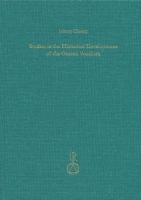Search
Studies in the Historical Development of the Ossetic Vocalism
2002
17.0 x 24.0 cm, 364 p., 2 maps, 2 Karten, cloth
ISBN: 9783895002670
17.0 x 24.0 cm, 364 p., 2 maps, 2 Karten, cloth
82,00 €
ISBN: 9783895002670
Short Description
Ever since Ossetic was extensively researched by eminent Iranists like Abaev, Bailey, Gershevitch and Benveniste, the language has earned a prominent place in (Indo-)Iranian and Indo-European Linguistics. Dealing with phonology together with etymological and morphological considerations, this study is the latest comprehensive treatment of the Ossetic language, since E. Benveniste, Études sur la langue ossète, in 1959.Description
Ossetic is an archaic Iranian language, which is primarily spoken by roughly a half million people in the Caucasus. Nowadays fully surrounded by non-Iranian peoples, the speakers of Ossetic are the last descendants of those North Iranian tribes, such as Cimmerians, Scythians, Saka, Sarmatians and Alans, who used to roam the vast Eurasian steppes. It is for this reason that Ossetic contains a wealth of information which attests to their historical contacts with many and ethnically very diverse groups, like Caucasians, Finno-Ugrians, Slavs, Goths, Greeks, Turks and Mongols. Despite its isolation and recent attestation, the language has essentially kept its Iranian character, moreover, being in appearance at least as conservative as a Middle Iranian language, such as Sogdian, Chorasmian or Khotanese. In the present work a comprehensive account of some important developments which took place in the phonology of that language is given. The developments comprise apocope (loss of final vowel), syncope (loss of medial vowel), aphaeresis (loss of initial vowel), i-epenthesis (insertion of *i) and accompanying palatalization, and finally, the fate of *u. Also the role of the accent in these cases is addressed. None of these developments has been subjected to a systematic treatment before. The book also contains a valuable contribution to etymology, as for this research Ossetic words are gleaned and assessed from the monumental work of the eminent scholar Vasilij Abaev, Historical-Etymological Dictionary of the Ossetic language. Finally, morphology is also touched upon in an extensive appendix, in which several nominal suffixes and the verbal endings are treated. The book is a contribution not only to our understanding of Ossetic itself but also to the advancement of Iranian and Caucasian studies.Reviews
„The volume under review is one of the most successfull attempts to systematize and synthesize the aforementioned results of linguistic studies on Ossetic vocalism and etymology.“In: Studia Etymologica Cracoviensia (SEC). 12 (2007)
--------------------------
„(...) muß man Cheungs Buch aber bescheinigen, daß es sehr benutzerfreundlich ist. Schon der etymologische Index, der so etwas wie ein kleines Etymologikon des Ossetischen darstellt, ist sehr hilfreich, und der ausführliche Index of Words erleichtert das Auffinden der angeführten Wortformen ganz ungemein.“
In: Kratylos. 49 (2004). S. 86-91.
Biographical Note
Johnny Cheung studied Indology and Indo-European Linguistics in Leiden, Holland. For his PhD research he studied in London and also made a field-trip to (Alania) North Ossetia, Russia. In September 2000 he defended his thesis, which resulted in the present publication. After his thesis he studied Persian as well. He is currently compiling a database/dictionary of the Iranian verb, focussing his attention on the Old and Middle Iranian material. His interest also lies in the research of modern Iranian dialects. For this purpose he will carry out field-work in Iran during the summer months in the present and coming years.Series Description
The series Beiträge zur Iranistik was founded in the 1960s by Georges Redard and subsequently edited by Nicholas Sims-Williams from 1997 to 2020; the present series editor is Agnes Korn. The series publishes works on the languages of the Iranian branch of Indo-European. The focus is on linguistics, including grammars, dictionaries, text editions, philology as well as diachronic and synchronic studies of linguistic topics. Neighbouring fields such as literature, archaeology and anthropology are likewise represented. The languages of the series are English, German and French. The Beiträge zur Iranistik are represented in libraries internationally and are widely used standard works of Iranian studies.Verwandte Reihen:




 Preface
Preface

 Neuerscheinungen 2023/2024
Neuerscheinungen 2023/2024
 Gesamtverzeichnis 2023/2024
Gesamtverzeichnis 2023/2024
 Katalog Oriental Studies & Linguistics
Katalog Oriental Studies & Linguistics
 Mittelalter
Mittelalter
 Deutsche Inschriften
Deutsche Inschriften
 Musiktherapie
Musiktherapie
 Literaturen im Kontext
Literaturen im Kontext